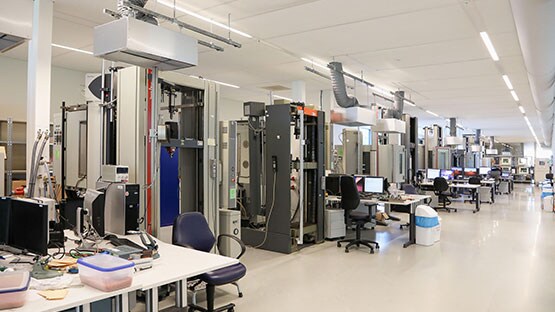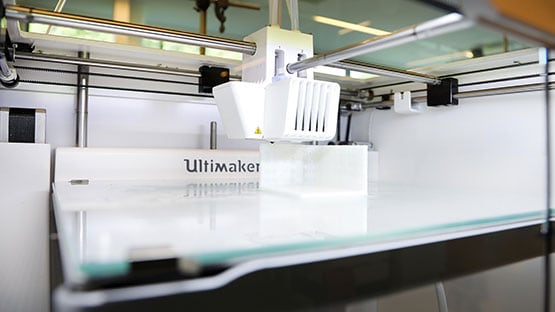
How does DSM see the development of 3D printing?
“For a long time, 3D printing was mainly used for making prototypes, but in a number of markets it’s now being deployed as a fully-fledged production technology. That’s still on a relatively small scale, but the change has in fact been evident for the past year and a half. More and more companies are investigating what 3D printing can mean for them as production businesses, and how it helps them shift toward digitization and connected or distributed manufacturing. Most of the larger production companies now have a department that focuses entirely on ‘additive manufacturing’.”


What’s driving this change?
“It’s the wish of the consumer. We are living in an increasingly personalised world. It used to be that when you wanted to buy a car, it was automatically the proverbial Model T Ford – ‘any colour as long as it’s black’. But when you order a new car nowadays, you almost need a university degree to choose from the hundreds of available options. As a result, it takes four or five months before the car is actually delivered. While we want personalised products, we don’t yet have the processes to support our demand. That’s where 3D printing comes into the picture. In markets involving small production runs or in which highly complex supply chains have developed, 3D printing can be a cost-effective alternative. Dental prostheses or hearing aids, for example, are by definition personalised as it highly improves patient comfort. That’s why 3D printing is gaining ground so rapidly within those markets. Another driving factor is the fact that engineers and designers are slowly letting go of the design rules that are linked to traditional production methods. 3D printing is overturning all those rules. In fact, there are no more rules, and you can do whatever you want. In ten years’ time, the youngest generation of designers and engineers will be occupying positions in which they are the ones who make the design decisions for their company. That will accelerate the introduction of 3D printing enormously.”
And what about the supply side?
“Of course, in order to make all this possible, the necessary developments still have to take place on the materials and costs side. One of the biggest technological challenges is to develop new materials for 3D printing. That’s where we come in. DSM supplies thousands of materials suitable for injection moulding, but the range of materials suitable for 3D printing is still just a fraction of that. That’s why we started investing in this technology a few years ago, and a lot of new materials will be coming onto the market in the years ahead.”
Which market segments is DSM targeting?
“These are healthcare, sport and lifestyle, transportation, manufacturing tools, and electronics. Within those segments, major investments are currently being made in additive manufacturing, because there’s a need, for example, for personalised products or new designs, and also because 3D printing offers competitive advantages in both the short and long term. Moreover, DSM is already operating in these markets with other business units, so we know the applications and we already have a relationship with the main players.”
What are DSM’s aims in the 3D printing market?
“We’ve been operating in this market longer than any of our competitors. The knowledge and experience that we’ve gained over the past 25 years, combined with our familiarity with the applications, puts us in a unique position. That enables us to understand what the market needs, and to make faster and more effective decisions so as to stay ahead. Our aim is to follow the growth of the market – and we’re talking about a growth of several orders of magnitude. If we’re supplying the material today for just one 3D-printed part for a single model of car from a single manufacturer, then in a few years’ time we want to be supplying materials to ten manufacturers for ten parts for ten models. Any firm that’s well positioned in this market and remains so will experience such growth. That’s our aim.”


At the end of 2017, DSM transferred all its 3D printing activities to a new business unit. Why that change?
“Those activities used to be organised according to technology, and they were scattered across various different business units and R&D departments. But the key to success in this market is an approach that focuses on the applications, on how you apply the technology. Because ultimately it doesn’t matter if a customer uses a powder, a resin or a filament; all that matters is how we can help him to make his designs 3D-printable and deliver the best materials for doing that. That’s why you need to combine all the relevant technology and know-how.
The other reason for the change is that it gives us more freedom to form partnerships. Ecosystems grow up around applications, comprising printer and material suppliers, software developers, universities, service providers, and, of course, customers themselves. I’m convinced that these types of ecosystems are essential for the rapid acceptance and growth of 3D printing. We therefore need to be part of those ecosystems and be able to form partnerships with the various players within them.”
What’s the biggest challenge posed by the change?
“The biggest challenge is to try to understand the changes that lie ahead, and to make sure that we have people who understand what it means to change. The development of 3D printing as a fully-fledged production method is leading to the complete transformation of entire value chains and supply chains. You therefore need to constantly think about which business model you can use so as to take advantage of the changes and opportunities within the market, otherwise you’ll be left behind. That’s why we’ve brought in a lot of new people, from both inside and outside DSM. We’re looking for a certain mind-set; we’re working in a dynamic environment for which you need dynamic people. That means being open to change and being able to deal with insecurity, both of which are things that people inherently don’t like. You also need people who can build up an organisation with structure and processes. You need a mix.”


What does working with so many partners and new business models mean for DSM?
“For each of the market segments that we focus on, we analyse which business model will lead to the fastest introduction of 3D printing for each of the applications concerned. We may well apply different business models in different markets. For example, most dentists outsource the production of crowns to laboratories that may now still be customers of ours. But it’s conceivable that there will soon be thousands of dental practices with their own 3D printer, and that crowns will soon be printed while the patient is being treated. How can we promote this development, and how can we then serve these individual dentists so they can treat patients better and faster ? For us, it’s essential to find the right business models for these new situations. We can’t do it all on our own, which is why we are trying to create ecosystems with the right partners. That’s the only way to keep up with the pace of change in the world we now live in. Without partners, life will be a lot more difficult!”
“3D Printing is becoming more than just a technological innovation”
Within the domain of ‘smart industry’, PwC considers 3D Printing as one of the eight essential disruptive technologies companies need to integrate and deploy in order to be future-proof. “3D Printing is beginning to disrupt manufacturing – from design and development to production”, states Roger Quaedvlieg clearly. At PwC he is part of the Industry 4.0 team.
“3D Printing is becoming more than just a technological innovation and is having impact on the entire business model and value chain of our clients in the market. From the printing of jet engine parts to instantly printed mouth guards, the technology is being hailed as a revolution in how more and more products will be developed, produced…and even sold”.
Read more about 3D Printing and Industry 4.0.
Contact us


















